When I first got on with my department I was about two thousand dollars deep in gear, uniform parts, and every cool whizbang doodad that I was told I’d need. That was before I even went to the State Academy. When I graduated from basic and was sworn in, I was issued a whole bunch more stuff from my department Quartermaster to include all of my issued and mandatory riot gear: full soft armor or the “turtle suit” as we call it, a huge poncho and tactical fanny pack (yes, seriously…a fanny pack), an ironwood riot baton, and what seemed to me to be a medieval-era OD green riot helmet and face shield with a blue ripstop helmet cover.

The helmet was a heavy monstrosity; ill-fitting, uncomfortable, with an old slimy leather headband harness system that had undoubtedly been issued and reissued several times over the years. That helmet sat in my riot bag and saw a lot of use for about four years until I was issued a newer IIIA-rated helmet when I went through patrol rifle school.
Now, several years later, with an unprecedented onset of officer ambushes, barricaded suspects, and more and more suspects using rifle rounds (7.62 seems to be very popular around my neck of the woods these days), departments such as my own are looking at procuring rifle-rated armor for ALL patrol officers, not just the long gun officers like me. No small task with over 1300 sworn.
While I applaud my department’s brass for taking officer safety via equipment and training seriously, we are severely lacking in the ballistic helmet arena. Many of my fellow officers still deploy every day with outdated helmets, and many of us have accepted the reality that we must shell out our own money for more modern, up to date equipment that will provide us better protection as the very real threats against us have undeniably escalated.
Critics can lament the perceived “militarization of police” all they want, I am tired of that old dirge. If a piece of equipment, in conjunction with proper training, enhances the likelihood I get to go home to my family every day, I will welcome the criticism gladly.
To this end, I have no problem spending my money on quality gear, and I have spent the money, thanks to the counsel of my friends at Tactical Night Vision Company, to purchase a Gentex TBH-II ballistic helmet for duty use as well as training classes that I attend on my own time.
Unfortunately for me, the lead time is significant, and I expect to have my new helmet in hand in a couple of months, leaving me with my issued ACH-style helmet for the summer months, which is undeniably our busier time of the year.
In the interim, I casually spent some time looking at various helmets including offerings from Revision Military, Gentex as previously mentioned, and Ops Core – with prices ranging from $650 fully apportioned, up to $1400 retail for the more boutique well-known name brand companies.
You can imagine then, my incredulous attitude when I heard of a company called Hard Head Veterans that advertised a high-cut IIIA helmet fully apportioned…for $425 retail. Too good to be true? Quite possibly, but I’m no expert…and I’d dare say most reading this, outside of my industry friends who are actually wearing these products in real life or developing them, will know what to look for when it comes to helmet features, fabrication, manufacturing, and testing.
All this being said, this is not a review, rather an opportunity to hear from Hard Head Veterans regarding their helmets, and a compilation of straight-forward questions I posed to them that I had myself, or saw online perusing various forums.
Let’s be real about it – we all want the best “bang for our buck” so to speak, but when it comes to personal protection, playing around with budget armor or proclaimed ballistic protection is no joke. I for one would rather pay more for equipment with a vetted pedigree, but what exactly does that mean? Where are materials sourced from? Where is the product made? What quality control measures are put into place to ensure that the product will do what is claimed? What is the company’s track record, how much data is available to prove real-life positive results thus proving that the product works as advertised?
I received an evaluation helmet from Hard Head Veterans a few weeks ago, and sent along some interview questions to Kit Dumph, the Director of Sales and Marketing.
Chris Tran (CT): Kit, what is your position with Hard Head Veterans, and how long has HHV been around?
Kit Dumph (KD): HHV was founded about 3 years ago, and my official title is Director of Sales & Marketing.
CT: I was introduced to your company via Warrior 12 Apparel, which produces much of the product for Blue Lives Matter, a media and resource outlet that I believe to be an important source of LE-related information, exposure of issues, and news. I am of the understanding that you and other members of HHV are currently active military and law enforcement. Would you describe the makeup, inception, and goals of your company?
KD: HHV was founded to solve the issue of getting up to date ballistic helmets into the hands of those that need it the most. Even at the Special Warfare level where I and a few others come from, we got issued the ATE (above the ear) style helmets way too late in the game. Some guys would go out and buy their own at the cost of a mortgage payment, and we had a feeling that we could do better. We feel like we have! Fast forward, we operate our company a little differently than most, as we try to utilize other veteran and LEO run business or individuals for our day to day operations. Everything from CAD design, fulfillment, accounting, bookkeeping, social media, etc. is all run by MIL/LEO, many who are still serving.
The goal of the company right now is finding a solution to what we call the 5.56 and 7.62 problems. That is basically providing a helmet that can safely stop these rounds at 15ft. We have been down a lot of rabbit holes working on this, but each one gets us a step closer. To the point that we have a solution, and now just have to find the best way to implement it.
CT: Ballistic protection is no joke. Military and First Responders alike only get one chance to get it right when selecting safety equipment that literally makes the difference between life, death, or a Traumatic Brain Injury (TBI). Most of us believe in the adage that “you get what you pay for.” In direct contrast, let’s be honest, cops are cheap. How does Hard Head Veterans navigate these two opposing and somewhat paradoxical positions? How much ballistic protection is “good enough?”
KD: We would add to the statement “you get what you pay for”, “to an extent”. The best analogy here might be a Glock vs Wilson 1911. The Glock is going to be 3/4’s less than the Wilson, yet we would rely on either one in a critical situation. Due to branding, first to market, innovation, and also very large government contracts, our competitors get to charge a premium for their products.
CT: The Hard Head Veterans Above The Ear (ATE) helmet is fabricated from DuPont Kevlar aramid fiber, but there’s more that goes into a ballistic helmet than just the name brand material. Without getting into your profit margins (as that’s no one’s business), how are you offering the ATE for the price point you can?
KD: Following on from the last question, the largest cost savings for us is we aren’t overcharging for our goods nor will we as we grow. The second big piece is we use overseas manufacturing to bring the cost of these helmets down further. Compared to other manufacturing processes, making a helmet is extremely simple with the material being used the key. In our opinion, most of the innovation in the helmet industry comes from the fabric/thread companies. Due to the shape of our noggins, you can only design a helmet so many different ways.
CT: The big question comes down to fabrication and the trust/faith buyers place in their product. Call it xenophobia, fear of overseas production, or whatever. Can you tell readers how the HHV ATE is fabricated? What materials are used, where are your helmets made, HOW are they made, and what quality control assurances are standardized and in place?
For example, if quality materials are sourced domestically, but the helmets themselves are fabricated/assembled/cured overseas, what assurance does an American consumer have that the helmet will actually do what it is intended? Many reputable companies such as Apple and Nike outsource their fabrication to China, Viet Nam, the Philippines, India, etc. Even the fanboys of Arc’teryx must acknowledge that some of their favorite cool kid gear is fabricated in Canada, Bangladesh, India, and China. All this being said, even though most American consumers are comfortable using products produced overseas, buying equipment that could save ones’ life is different than buying a pair of shoes.
KD: Our lids are fabricated identically (material specific) to the ones that get made here in the states. We might even go as far to say that the machinery used, presses, molds, etc., are identical. They are basically made by combining layers of fabric until the desired protection level is achieved. As always, it’s a balance between meeting standards and weight. We then either source the non-ballistic parts from other companies or as of late are designing our own! We have a number of QC systems in place that happens both overseas with our partnered manufacturing plant and here in the States. This includes having a quality control manager at the plant itself, randomized batch testing (lab & in-house) and an annual full lab test to the identical standards that government issued helmets meet.
CT: Let’s talk about NIJ standards for a moment. Unlike some other companies, Hard Head Veterans has published your NIJ standard testing results directly on your website. Please explain to readers how your helmets are tested, what your acceptable standards are, and how they are similar/the same/different than other vetted companies that possess the lion’s share of the market.
KD: Most people don’t understand the depth of the testing helmets go through, and it’s a lot more than just the NIJ perforation tests. We post the most important ones in our opinion, in hopes of educating people on what they should be looking for. It’s become the standard and a must for governments bids to have things of this nature tested by a certified 3rd party laboratory. We use NTS or National Technical Systems for all of our testing and it’s a little too in-depth for this single paragraph. I’d point people to our Testing web page and also our blog if they would like to learn a little more:
Unfortunately, we haven’t found any companies publishing their testing reports, even the ones that have the lion’s share of the market. From the few numbers, we have seen on competitor websites our helmets match or outperform the large competitors when it comes to these tests.
CT: Back specifically to the ATE helmet itself, let’s talk about the components that go into the helmet. The ATE currently ships complete with injection molded side rails, a 4-point chinstrap retention system, a standard WARCOM 3-hole pattern shroud, NVG bungies, memory foam padding, and some rail accessories including picatinny rails, a flashlight mount, and a Surefire X300-compatible mount. However, these options are also upgradeable, allowing for the end-user to upgrade/change out these systems if desired. Is this where the majority of cost-savings comes into play? Is it possible to order an ATE helmet without any of the factory accessories, allowing the end-user to accessories their helmet with their preferred components?
KD: Yes, right now our full helmet ships with all of those things, and we have new features in the pipeline as well! This includes new rails, upgraded 4-point, our Comfort Plus Pads that already launched, and a few others! We do make our shell available for purchase as well by itself for those that want to customize on their own.
CT: When can end-users expect to see HHV-designed in-house accessories hit the market? If they are produced domestically; what improvements, either via design or quality should we expect to see?
KD: Not HHV designed, but our newest feature will be a magnetic/mechanical chinstrap made by FIDLOCK out of Germany. This will enable users the ability to quickly buckle and un-buckle chinstraps with a single hand. These are actually rolling out as we speak. Customers can expect to see new rails and shrouds within the year which will greatly increase design and function. Quality has never been an issue with our accessories either.
CT: As more of your helmets hit the market, has Hard Head Veterans compiled or received any testimonials of verified saves in the field, either domestically or overseas?
KD: We always pray that this isn’t needed, but we did get our first about a month ago. The soldier was in a nasty roll-over that landed him in the hospital. He stressed to us that the reason he is still alive was due to the helmet.
CT: How many HHV ATE helmets are currently in circulation? Are there any agencies, either LE departments or .gov agencies that have adopted your helmet as standard-issue, or on an approved buy list?
KD: We don’t want to disclose this number just yet, as we want our competitors in the dark. Answering your second question though, Yes! We have a long list of small to medium departments that have adopted our lids and love them. We also have a number of federal entities from the US Marshals to other 3 letter agencies that have adopted our helmets. We also supply a few US Government contracts for helmets going overseas to US allies (sorry for the generalities here, but we would want to ask for permission before we gave out specifics on these customers).
CT: Is there anything else you would like readers to know about Hard Head Veterans or your helmet fabrication and quality assurance process?
KD: We just want readers to know that quality protection shouldn’t come at the price of an entire months pay. That we strive to work with service providers (Police, Military, 3 letter agencies, etc.) to get them the protection they need and deserve.
The Rundown
My evaluation helmet quickly arrived in a basic cardboard box, was adequately packed, and came with all accessories mentioned above and a thin fabric carry bag. I inspected the helmet itself and saw no cracks, dings, dents, peeling, or otherwise obviously visible deformities. The rails were not completely tightened down to the helmet though, which was easily remedied by a couple of a flathead screwdriver. If I don’t swap out the rails, I’ll probably Loctite them down.
Now, according to my head measurements, I sit at 22” circumference, so I had ordered a Medium helmet. With the supplied pads, even with the headstraps fitted, there was a lot of lateral play back and forth. Wearing earpro – a set of Howard Leight Impact Sport Sounds and a set of Sordin MSA Supreme Pro-Xs remedied that issue, but will pose an issue if I use adaptor rails for the earpro as the helmet is rather spacious on the inside.
The Hard Head Veterans ATE is undeniably more streamlined and much lighter than my currently-issued helmet, coming in at just shy of three (3) pounds.

Now, the question comes to durability, and whether this brain bucket works or not. Mrgunsandgear already has a Youtube video in which he shoots his evaluation helmet, and Hard Head Veterans has plenty of video links to their testing protocols on Youtube that are readily accessible via their website and Youtube.
From my initial impressions, the ATE appears to work, and Hard Head Veterans appear to be pretty darn transparent with the capabilities and specs of their helmet offering. Here are the basic high points and bullet points from where I sit:
- The ATE is comprised of domestic DuPont Kevlar.
- The ATE is assembled in an overseas plant with HHV oversight and QC measures put into place.
- ATE helmet accessories – rails, straps, pads, and shrouds are internationally sourced at this time. This, in conjunction with the overseas assembly is how HHV keeps costs down, in addition to not charging a premium for brand-name pricing like other brands.
- Even though the ATE is assembled overseas with internationally sourced accessories, the ballistic performance of the helmet in of itself is still based off of American product and tested by NTS to NIJ Standard 0106.01, DOD Standard MIL-STD-662F, and AR/PD 10-02.
I believe that the hardest thing that Hard Head Veterans will have to overcome is perception as the new company on the block, as well as skepticism and concerns over fabrication. That concern is in my mind warranted, especially since life-saving equipment is not something to be trifled with.
I do appreciate that Hard Head Veterans will ship the helmet without the accessories so the end-user can upgrade it with accessories of their choice that have more name-brand recognition if that will instill more confidence in the product. A side note for comparison, look at Revision Military’s Batlskin Viper A3 High Cut Helmet, which comes unadorned without accessories and retails in the neighborhood of $350. Not too far off the mark for HHV’s fully-apportioned helmet.
Time will tell as field data comes in regarding the viability of the helmet itself, but it looks like several departments and even some .gov agencies have taken a look at the helmet chosen to use it in the real world, and not just on a square range. I’ll be bringing mine to various classes and knock it around in the next several months, we’ll see how it does and I’ll of course circle back around as I have more time with it.
Want to know more about Hard Head Veterans? Check them out and their testing protocol summaries on the web:
On Facebook
On Instagram






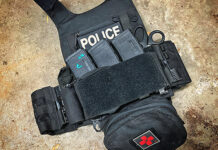
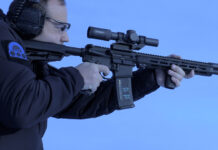
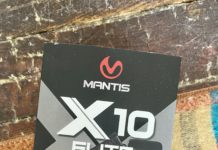
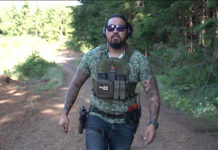
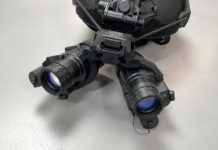
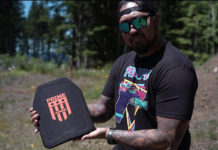
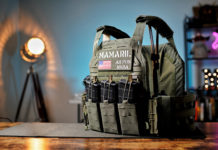
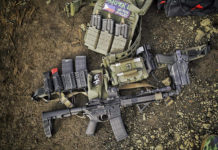
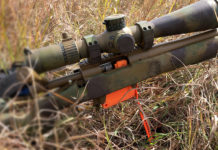

Rostov – HHV now uses an M-LOK style rail. However standard ARC rails can be fitted onto their helmets.
Hey what kind of arc rails are on your HHV ATE?
Are there any ballistic testing reports on ops core or other “high end” helmets? I’ve been really interested in getting the HHV but reluctant to pulling the trigger on one after seeing / hearing about the backface deformation during testing. At the same time, I can’t seem to find ANY evidence that the higher priced helmets do any better, which is frustrating..
Hi Chris, just wondering which helmet cover you’re using in that last picture? (the ranger green cover on helmet all loaded up with lights, counter weights, etc.) I cant seem to find an aftermarket company that makes a cover sized for this HHV ATE.
Carlos – Thanks for the comment. Unfortunately that particular helmet was not Chris. That was one of our military buddies helmets who was out shooting with/for us and I really don’t have a way to contact him currently. It appears to possibly be a TYR Tactical FAST Ballistic Helmet Cover. It may just be a bit of an older version. The article is from July of 2017 so it makes it tough to pin point the exact model. Thanks again for the comment and sorry I couldn’t help you more -Eric